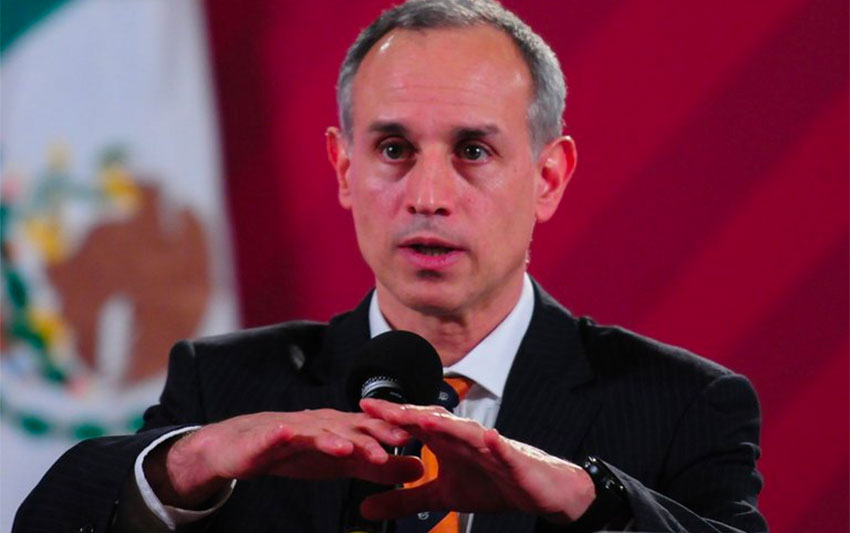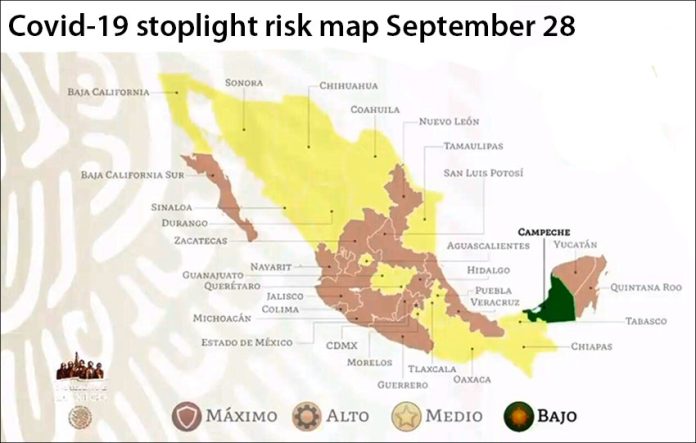Campeche will become the first state in the country to switch to green light “low risk” according to the federal government’s stoplight system to assess the risk of coronavirus infection.
The federal Health Ministry announced Friday that the Yucatán Peninsula state, which was also the first state to move from high risk to medium, will be painted green on the government’s stoplight map as of Monday.
“The state of Campeche is the first state in our republic to arrive at the green stoplight, it’s the lowest risk level. We have to remember that this doesn’t mean zero risk. This means that the dynamic of the epidemic has decreased enough to allow almost all economic and social activities to resume,” said health promotion chief Ricardo Cortés.
According to state government data, Campeche has recorded 6,031 confirmed cases of coronavirus since the start of the pandemic and 787 deaths. As of Friday there were just 43 active cases in the state.
Although federal authorities have said that schools can reopen once the risk level decreases to green, Deputy Health Minister Hugo López-Gatell advised Campeche to “be prudent” and not move to do so immediately.
Authorities in Campeche should carefully weigh the benefits and risks of reopening schools in the short term, he said.
Of Mexico’s 31 other states, 16 will start next week painted yellow on the stoplight risk map and 15 will be orange.
The yellow light states as of Monday will be Chiapas, Chihuahua, Morelos, Sonora, Tamaulipas, Tlaxcala, Baja California, Coahuila, Sinaloa, Durango, Aguascalientes, Guanajuato, Querétaro, Puebla, Oaxaca and Tabasco.
The first six states listed were already yellow while the other 10 will switch to that color from orange on Monday.
The orange light states as of Monday will be Baja California Sur, Nuevo León, San Luis Potosí, Zacatecas, Nayarit, Jalisco, Colima, Michoacán, Guerrero, México state, Mexico City, Hidalgo, Veracruz, Yucatán and Quintana Roo.
All but one of those states are currently orange. Quintana Roo will switch from yellow on Monday but state authorities have their own stoplight system and have indicated that it will remain yellow.

The federal government system considers 10 different indicators to determine the stoplight color allocated to each state.
The 10 indicators are:
- The Covid-19 effective reproduction rate (how many people each infected person infects);
- Estimated case numbers per 100,000 inhabitants;
- The weekly positivity rate (the percentage of Covid-19 tests that come back positive);
- Total case numbers;
- The number of coronavirus patients per 100,000 inhabitants;
- Hospital occupancy rates for general care beds;
- Hospital occupancy rates for beds with ventilators;
- Hospital admission trends;
- Covid-19 mortality rate (deaths per 100,000 inhabitants); and
- Covid-19 death trends (whether the number of deaths per week is increasing or decreasing).
Mexico is still recording several thousand new coronavirus cases per day and hundreds of Covid-19 deaths but López-Gatell, the government’s coronavirus czar, said Friday that the pandemic is on the wane in 27 of of the country’s 32 states.
“We have 27 federal entities that are already in a descending pattern; in other words, the daily number of cases registered, the number of hospitalizations, the number of deaths and the positivity rate [of Covid-19 tests] are declining,” he said. “These four indicators are generally behaving very consistently.”
López-Gatell said that the decline in those indicators has been seen in all 27 states for at least two weeks. The epidemics in Chiapas, Sonora and Sinaloa have been on the wane for six to eight weeks, while Campeche has seen the indicators decline for 12 weeks, he said.
The deputy minister said that the epidemics in Durango and Querétaro are still in a growth phase and that it is unclear when they will start to decline. The epidemics in Mexico City and Jalisco have plateaued, López-Gatell said. He didn’t identify the fifth state where the epidemic is not on the wane.
The deputy minister reiterated that Mexico is at risk of seeing a flare-up in coronavirus infections in the middle of next month and renewed his warning that Covid-19 and the seasonal flu will soon coexist.
He urged people to continue to observe social distancing recommendations, to wash their hands frequently, to wear a face mask and to stay at home if they have coronavirus-like symptoms.
“With this we’re going to continue having hope and results … in decreasing [new infections]. Tomorrow we’ll reach eight consecutive weeks of a decline” in nationwide case numbers, López-Gatell said.
Earlier in the press conference, Director of Epidemiology José Luis Alomia reported that Mexico’s accumulated case tally had increased to 720,858 with 5,401 new cases registered. The official Covid-19 death toll rose to 75,844 with 405 additional fatalities.
Mexico has the seventh highest accumulated case tally, according to data compiled by Johns Hopkins University, and ranks fourth for Covid-19 deaths behind the United States, Brazil and India.
Source: El Universal (sp), El Financiero (sp), Infobae (sp)
